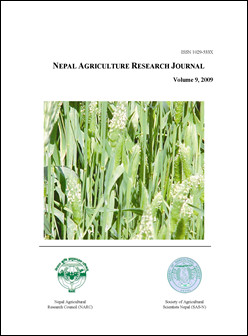Response of Cauliflower (Brassica oleracea var. Botrytis) to the Application of Boron and Phosphorus in the Soils of Rupandehi District
DOI:
https://doi.org/10.3126/narj.v9i0.11642Keywords:
Borax, Brassica oleracea var. botrytis, Curd yield, PhosphorusAbstract
A field experiment was conducted at Paklihawa Campus of the Institute of Agriculture and Animal Science, Rupandehi, Nepal, during Oct 2004 to Feb 2005 to study the effects of boron and phosphorus on the soil nutrient status, nutrient uptake by plant and yield of cauliflower (Brassica oleracea var. botrytis L.) variety Snowball-16. Sixteen treatment combinations, including four levels of boron (0, 0.65, 1.3, 1.95 kg boron ha-1) and four levels of phosphorus (0, 30, 60, 90kg P2O5 ha-1) were included. The soil was loamy with very low in boron. Curd yield, harvest index, boron and phosphorus uptake by plant and available boron in soil were significantly increased by the application of boron and phosphorus in soils. Available phosphorus in soils after the crop harvest was significantly increased by phosphorus application. The highest curd yield, boron and phosphorus uptake by plant as well as available boron and phosphorus in soils after the crop harvest were obtained from the application of 1.3 kg boron with 60 kg P2O5 ha-1. The boron uptake by plant was decreased by the application of more than 1.3kg boron ha-1 while the phosphorus uptake was increased with increased application of phosphorus upto 90 kg P2O5 ha-1. There were quadratic responses of curd yield, harvest index and plant boron uptake to the applied boron; quadratic response of plant phosphorus uptake to the applied phosphorus, while responses of curd yield, and harvest index to the applied phosphorus were linear. Highly significant positive correlations between curd yield and leaf boron content (r = 0.68**) as well as curd yield and plant phosphorus content (r = 0.79**) were observed. In conclusion, the combined application of 1.3 kg boron and 60 kg P2O5 ha-1 was found to be the best for cauliflower production under Paklihawa soil conditions of Rupandehi district and can be recommended to the growers of this region.
Nepal Agric. Res. J. Vol. 9, 2009, pp. 56-66
Downloads
Downloads
Published
How to Cite
Issue
Section
License
This license allows reusers to copy and distribute the material in any medium or format in unadapted form only, for noncommercial purposes only, and only so long as attribution is given to the creator.




